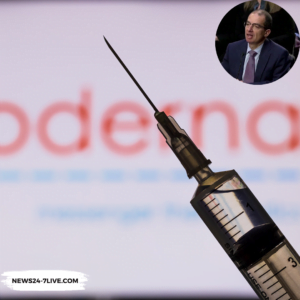Moderna has announced that its combination COVID-19 and influenza vaccine has demonstrated promising results in late-stage trials. The vaccine is known as mRNA-1083, not only generates a stronger immune response compared to separate shots but also shows potential for simplifying vaccination schedules. The company aims to introduce this combination shot by the fall respiratory season of 2025 or by 2026.

Also Read: FDA Approves Moderna’s mRNA RSV Vaccine for Older Adults
This is the first instance of a company releasing favorable phase three data for a combination shot, setting Moderna ahead of competitors such as Pfizer and Novavax.
Moderna intends to seek regulatory approval for the combination vaccine in the US during the summer of 2024 with hopes of market availability by 2025.
The combination vaccine aims to streamline the vaccination process offering a single shot for protection against both COVID-19 and the flu.
With a decrease in the number of Americans getting vaccinated against COVID-19, the combined shot is seen as a way to boost compliance and ease the logistical burdens on healthcare providers.
The combination vaccine, mRNA-1083 merges Moderna’s experimental vaccines for seasonal influenza (mRNA-1010) and a next-generation COVID-19 vaccine (mRNA-1283). Both components have shown promising results in separate phase three trials.
The late-stage trial involved 8,000 participants, split into two age groups, one consisting of individuals aged 65 and above and the other comprising individuals aged between 50 and 64.
Each age group received either the combination shot or a comparative regimen involving an enhanced flu vaccine (Fluzone HD for the older group and Fluarix for the younger group) and Moderna’s COVID-19 vaccine, Spikevax.
A single dose of the combination vaccine generated higher immune responses against three strains of influenza and the COVID-19 omicron variant XBB.1.5.
The immune response was better compared to the individual flu vaccines and Spikevax particularly in older adults, who are at higher risk of severe illness.
The combination vaccine exhibited an acceptable safety profile similar to that of the standalone vaccines used in the trial.
Common side effects included pain at the injection site, fatigue, muscle pain and headaches, most of which were mild to moderate.
The favorable safety results suggest that the combination shot could become a viable option for broad use, simplifying the vaccination process for both consumers and healthcare providers.
By reducing the number of injections needed, the combination vaccine can alleviate some of the workload on pharmacists and the healthcare system in the face of ongoing labor shortages.
While initial trials focused on older adults, Moderna plans to extend the vaccine’s availability to younger populations in the future.
Moderna is also exploring the development of other combination vaccines including a flu and respiratory syncytial virus (RSV) shot and a triple vaccine targeting COVID-19, flu, and RSV.
Competitors such as Pfizer and BioNTech are also in the process of developing combination vaccines, which are anticipated to be faster to produce and more adaptable to changing virus strains due to their mRNA technology.
Also Read: First Human Case of H5N2 Bird Flu Reported in Mexico, WHO Confirms
Moderna’s mRNA-based approach allows for quicker updates to the vaccine to match circulating virus strains.
Moderna is expanding its mRNA technology to develop treatments for other diseases including personalized cancer vaccines in partnership with Merck and a potential vaccine for cytomegalovirus, a major cause of birth defects.
Moderna’s mRNA-1083 combination vaccine elicited a higher immune response against three major flu strains (H1N1, H3N2, and B/Victoria) and COVID-19 when compared to traditional flu vaccines and Moderna’s standalone COVID-19 shot, Spikevax.
The trial results showed that older adults aged 50 and over produced greater antibody levels with the combination vaccine compared to those who received the traditional flu vaccines from GlaxoSmithKline (GSK) and Sanofi and the Spikevax COVID-19 vaccine.
The vaccine was tested in a Phase 3 trial involving approximately 8,000 participants divided into two groups.
One group received the combination vaccine and the other received separate shots of Spikevax and either GSK’s Fluarix or Sanofi’s Fluzone HD, a high-dose flu vaccine for seniors. The combination vaccine outperformed the individual vaccines in both efficacy and immune response.
The combination vaccine could ease the burden on healthcare systems by reducing the need for multiple vaccinations.
This is especially important given the high number of annual flu cases and the impact of COVID-19. In the United States alone, the Centers for Disease Control and Prevention (CDC) estimates that flu infects 35 to 64 million people annually leading to hundreds of thousands of hospitalizations and tens of thousands of deaths.
The combination vaccine was found to be safe and well-tolerated with side effects similar to those of the existing vaccines.
The most common side effects included pain at the injection site, fatigue, muscle aches and headaches.
Moderna plans to submit the vaccine for regulatory approval and plans to launch it by the fall of 2025. If approved, mRNA-1083 would become the company’s third product on the market following its COVID-19 vaccine and the approved RSV vaccine for older adults.
The combination vaccine has the potential to address the declining demand for standalone COVID-19 vaccines by offering a more effective option for both COVID-19 and flu protection.
Moderna is already exploring the development of a triple vaccine to protect against COVID-19, RSV, and the flu. Other companies including Pfizer and Novavax are also working on their own combination vaccines.
Also Read: Xylitol: Popular Sugar Substitute Linked to Increased Cardiovascular Risk























